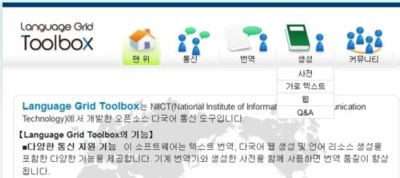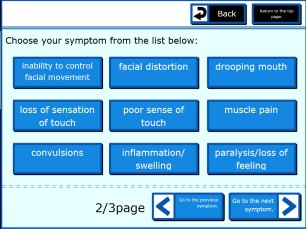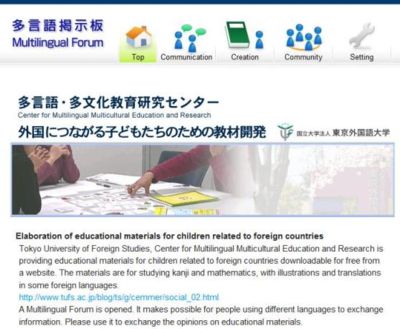Contents
[Service Grid Open Source Activity Started Globally]
![]()
[New Function of Language Grid Toolbox: Language Settings]
![]()
[Monthly Maintenance for September and October]
![]()
[Web Application Version of M3 Is Now Open to the Public]
![]()
[Language Grid Users] Center for Multilingual Multicultural Education and Research
![]()
Service Grid Open Source Activity Started Globally


The Service Grid-related software developed by NICT, Kyoto University, and other organizations has been moved to the Service Grid open source project. This project publishes the source code of the software under open source licenses and allows anybody to take part in the development process.
Currently, three types of software are being developed in this project.
Service Grid Server software is the basic software to collect and share Web services. By wrapping resources, including complicated intellectual property such as copyrights, and sharing the Web services, it enables providers to offer services while protecting their resources.
Language services are Web services that allow users to access language resources such as machine translators and bilingual dictionaries. Service interface definitions corresponding to each language resource type and wrapping libraries to develop language services compliant with the definitions are provided. The Language Grid is a service grid applied in the language domain to share language services.
Language Grid Toolbox is an intercultural collaboration tool using the Language Grid for multilingual communities.
Service Grid Server software and the language services are published under the LGPL license and Language Grid Toolbox under GPL license, respectively.
- Participating in Open Source Activities
Anybody can take part in the open source activities by creating a user account at the Open Source Project Community Site. By clicking the "Sign up" button on the top page and completing the necessary information, you can create your own account.
- Posting Requests and Questions
Members can access the multilingual BBS in the community site using their accounts. The BBS provides forums for each type of software so that members can post their requests and questions about that software. The posted requests and questions are answered by other members in the community. Moreover, the requests are considered by developers in the community when developing new functions.
- Procedure for Software Development
Anybody with software development technologies can participate in development related to the Service Grid software. In the Service Grid Open Source Project, there are two types of software components: core components and optional components. Agreement within the community is required for the extension and modification of core components, while optional components can be freely developed based on the requirements of the developers. The classification of components is decided respectively for different types of software (Service Grid Server software and Language Grid Toolbox).
Developers need to obtain the source code from the published source code repository and conduct the development on local machines. The source code repository is available in SourceForge, where many open source software projects are published. Some users have already developed an extended version that adds a speech recognition function to the current text translation.
The open source project is expected to result in better software with the active participation of many users in feedback and development. We welcome the participation of Language Grid users and Language Grid Toolbox users.
New Function of Language Grid Toolbox: Language Settings

A new function of language settings has been released for Language Grid Toolbox in August 2010. Using the language settings function, users can configure display languages and set text labels for the languages. The standard Language Grid Toolbox provided English and Japanese as the display languages. However, it is now possible for community members to use this new function to add any display language based on their own requirements.
To add a new display language, users first need to download the file of the default language settings (English) for each module, including the messages and text labels. Then, it is necessary to translate the messages and text labels in the downloaded files and upload the translated files in the language settings function. After uploading the translation files for language settings, the added language will be displayed in Toolbox.
Monthly Maintenance for September and October
The next maintenance of the Language Grid will be conducted on the Mondays of September 6 and October 4, at 18:00-21:00 JST. If you wish to use the Language Grid during this period, please contact us in advance at operation [at] langrid.org.
Web Application Version of M3

A web application version of Medical Interview Sheet Translation System (M3), developed by Yoshino Laboratory at Wakayama University and the Center for Multicultural Society Kyoto is now open to the public.
M3 is system that can enable a non-native Japanese user to complete a health interview on the Internet using their first language from home. You can print out the result and forward it to a cellphone, so you can take it to a hospital and convey the right symptoms to the doctor and hospital staff.
At the moment, the system supports Japanese, English, Chinese, Korean, Portuguese, Indonesian, and Simple Japanese (Japanese that is easy for non-native Japanese people to understand).
Language Grid Users: Center for Multilingual Multicultural Education and Research

At the Center for Multilingual Multicultural Education and Research of Tokyo University of Foreign Studies, we are running a Project on the Elaboration of Educational Materials for Foreign Children, offering it as a free download from our website.
We use simple Japanese explanations with many illustrations, with some parts translated for children who are not fluent in Japanese, enabling them to enjoy their study.
We considered the possibility of creating an Internet discussion board for speakers of different languages, enabling them to exchange ideas freely about how to use the materials and how to study. We subsequently heard about the Language Grid, and we have been participating as a service user from October 2009.
We released Multilingual Forum using Toolbox in May 2010. The Portuguese language is also displayed for Brazilian people, who account for a large number of users. We hope Multilingual Forum will help students solve questions that arise in their daily study and encourage an exchange of information about how to teach in a way that overcomes the language barrier.
